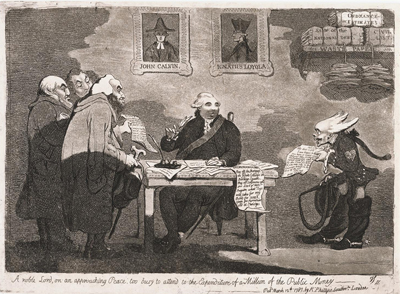A Noble Lord, on an Approaching Peace. . .
As the full subtitle explains, this rather odd print shows a "Noble Lord" (Shelburne aka Lansdowne), "too busy to attend to the Expenditure of a Million of the Public Money." These expenditures presumably include the items relegated to the shelf behind him (significantly labeled "Waste Paper") namely, "Ordnance Estimates," the "Civil List," and the "State of the National Debt." The "Ordnance Estimates" would include projected expenses for the supply and storage of cannons and heavy artillery, rifles and guns, ammunition, and other weaponry used in wartime. The "Civil List" would tally expenses for all governmental place holders, and pensions. And the "National Debt" and the interest on it would result if those other expenses were not able to be paid (as in fact they weren't) from current revenue.

© Lewis Walpole Library, Yale University
But, as we can see, the Noble Lord's focus is not on these basic concerns of a functioning government, but rather on his personal finances. The papers labeled Memorandum on his desk and the note in the hand of the money lender provide a good idea of the personal expenses that currently preoccupy the noble Lord.
Pay off the Mortgage on Jesuits Colledge in Berkeley Square [his own home]
Pay off Solomons [annuity] for 500£ pr Annm
Inquire what Tayt will take for my Bond for 3000£ given for furniture sold at Christyes'.
And we can infer from the note in a French messenger's hand that the solution to the noble Lord's financial entanglements is to benefit from the sudden rise in value of companies benefiting from the soon to be announced preliminary peace agreement with France.
My dear Lord,
I am happy to hear you have so nearly concluded your Alley Arrangements. The Preliminaries shall be signed coute que coute by the Time you desire.
But all of this makes sense ONLY IF this is 1783 when the noble Lord Shelburne was First Lord of the Treasury and therefore responsible for the government's finances. In March of 1797, the publication date of Gillray's print, and when another treaty with France was pending, Shelburne was out of office and a private citizen. To make matters even more confusing, the French messenger's letter is, in fact, dated 7 January 1783, which would seemingly make it impossible to interpret this print as applying to the 1787 French Commercial Treaty. And yet it is supposedly signed by "Billy Paradice" i.e. William Eden, who was uninvolved with the 1783 treaty, but the chief negotiator of the 1787 agreement.
The kindest explanation of this farrago (and the one that Wright and Evans and the British Museum seem to adopt) is that the print was created in 1783, but never used. Then in 1787 when Shelburne (now the Marquess of Lansdowne) came out in support of Pitt's and William Eden's French Commercial Treaty, Gillray resurrected the print to suggest that Landowne's support was personally motivated. But if that was the aim, the title, background, and the date on the messenger's letter, are all irrelevant and misleading. And that would suggest a degree of carelessness on Gillray's part that would be highly unusual.
But the disconnect between the date and the content of the print is not the only odd thing about the print. There is also the question of the publisher. This is one of three prints which all appeared in or around March of 1787 supposedly published by R. Phillips, Southwark London. The other two are: The Minister Endeavoring to Eke Out Dr Pr*ty***n's Bisho-Prick, and The Board of Controul, or the Blessings of a Scotch Dictator. But, so far as I can tell, Phillips is a fiction, an invention of Gillray's. The British Museum catalog lists no other prints published by R. Phillips, except the three created by Gillray in March 1787. And the entry in the Exeter Working Papers in Book History for R. Phillips simply refers to the British Museum catalog.
All three prints are unsigned by Gillray, but "signed" with James Sayer's well known but easily imitated, logo. One can only conclude that though Gillray may have published the three prints himself, he wanted his name kept as far away from the prints as possible. He may have chosen Sayers to foist the authorship upon because Sayers name and work had definite cachet, but because two of the prints were critical of Pitt, they would be clearly understood as parodies (Sayers being on Pitt's payroll).
I wish I had a cogent argument to explain all this, but I don't. But my sense is that the three prints, for the reasons above and for the obvious stylistic similarities in the treatment of faces and the extensive and beautiful text within the print, need ultimately to be discussed together.
Sources and Reading
- Commentary from the British Museum on A Noble Lord, on an Approaching Peace. . ..
- "William Petty, 2nd Earl of Shelburne," Wikipedia
- "Eden Agreement," Wikipedia
- "Peace of Paris (1783)," Wikipedia
- Thomas Wright and R.H. Evans, Historical and Descriptive Account of the Caricatures of James Gillray #21.
- Thomas Wright and Joseph Grego, The Works of James Gillray, the Caricaturist; With the History of His Life and Times, p. 85.
Comments & Corrections
NOTE: Comments and/or corrections are always appreciated. To make that easier, I have included a form below that you can use. I promise never to share any of the info provided without your express permission.